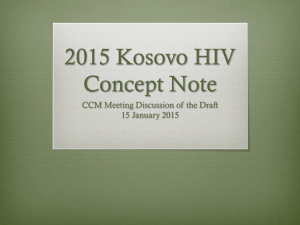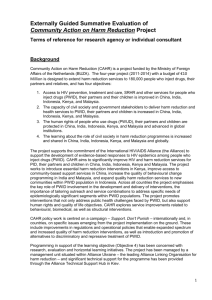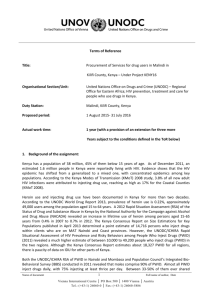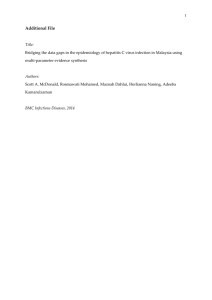Terms of Reference - the United Nations Office at Nairobi
advertisement
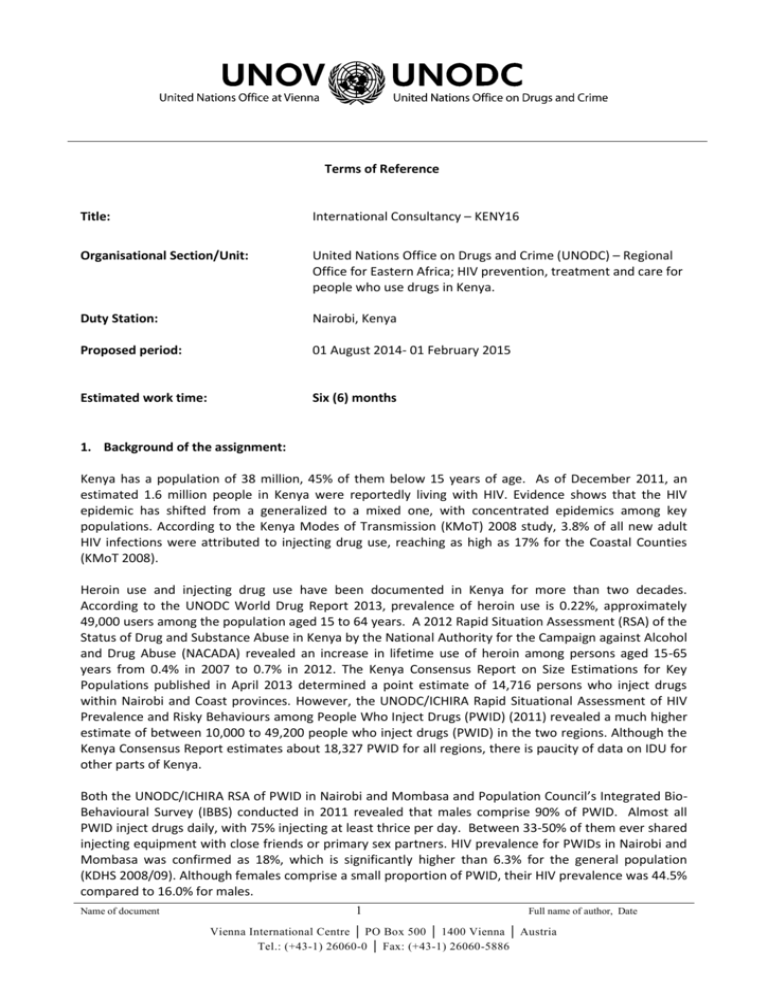
Terms of Reference Title: International Consultancy – KENY16 Organisational Section/Unit: United Nations Office on Drugs and Crime (UNODC) – Regional Office for Eastern Africa; HIV prevention, treatment and care for people who use drugs in Kenya. Duty Station: Nairobi, Kenya Proposed period: 01 August 2014- 01 February 2015 Estimated work time: Six (6) months 1. Background of the assignment: Kenya has a population of 38 million, 45% of them below 15 years of age. As of December 2011, an estimated 1.6 million people in Kenya were reportedly living with HIV. Evidence shows that the HIV epidemic has shifted from a generalized to a mixed one, with concentrated epidemics among key populations. According to the Kenya Modes of Transmission (KMoT) 2008 study, 3.8% of all new adult HIV infections were attributed to injecting drug use, reaching as high as 17% for the Coastal Counties (KMoT 2008). Heroin use and injecting drug use have been documented in Kenya for more than two decades. According to the UNODC World Drug Report 2013, prevalence of heroin use is 0.22%, approximately 49,000 users among the population aged 15 to 64 years. A 2012 Rapid Situation Assessment (RSA) of the Status of Drug and Substance Abuse in Kenya by the National Authority for the Campaign against Alcohol and Drug Abuse (NACADA) revealed an increase in lifetime use of heroin among persons aged 15-65 years from 0.4% in 2007 to 0.7% in 2012. The Kenya Consensus Report on Size Estimations for Key Populations published in April 2013 determined a point estimate of 14,716 persons who inject drugs within Nairobi and Coast provinces. However, the UNODC/ICHIRA Rapid Situational Assessment of HIV Prevalence and Risky Behaviours among People Who Inject Drugs (PWID) (2011) revealed a much higher estimate of between 10,000 to 49,200 people who inject drugs (PWID) in the two regions. Although the Kenya Consensus Report estimates about 18,327 PWID for all regions, there is paucity of data on IDU for other parts of Kenya. Both the UNODC/ICHIRA RSA of PWID in Nairobi and Mombasa and Population Council’s Integrated BioBehavioural Survey (IBBS) conducted in 2011 revealed that males comprise 90% of PWID. Almost all PWID inject drugs daily, with 75% injecting at least thrice per day. Between 33-50% of them ever shared injecting equipment with close friends or primary sex partners. HIV prevalence for PWIDs in Nairobi and Mombasa was confirmed as 18%, which is significantly higher than 6.3% for the general population (KDHS 2008/09). Although females comprise a small proportion of PWID, their HIV prevalence was 44.5% compared to 16.0% for males. Name of document 1 Full name of author, Date Vienna International Centre │ PO Box 500 │ 1400 Vienna │ Austria Tel.: (+43-1) 26060-0 │ Fax: (+43-1) 26060-5886 According to WHO/UNODC/UNAIDS and USG/PEPFAR guidance on HIV prevention among PWID, two critical and interrelated components of an effective response to drug and HIV epidemics are (i) Opioid substitution therapy (OST) as well as needle and syringe programmes (NSPs), together with (ii) HIV Testing and Counselling and the provision of antiretroviral therapy for those who need it. NSP has recently been implemented and plans are underway to implement Opiate Substitution Therapy (OST). Kenya is embarking on an ambitious plan to rapidly scale-up of interventions to prevent new HIV and hepatitis infections among people who inject drugs (PWID) and enhance their well-being and quality of life by the introduction of the core elements of the United Nations and USG/PEPFAR guidance on HIV prevention among PWID. Achieving high coverage rates, and monitoring progress in reaching PWID for core interventions is critical to impacting and the further spread of HIV among PWID. Kenya, with support from USG/USAID, UNODC and UNAIDS will be implementing a comprehensive HIV public health harm reduction programme with a major focus on introducing and scaling-up core interventions methadone maintenance services in Kenya and particularly Mombasa. There is strong supporting literature and evidence indicating that high quality and high coverage OST programmes that retain PWID in treatment reduce drug use, injection frequency, prevent HIV transmission and facilitate entry and adherence in ART programs. Critical to the programme is monitoring the progress towards achieving the overall goal of averting new HIV infections, preventing morbidity and mortality is establishing a robust programme centered Monitoring and Evaluation approach that includes setting targets according to the WHO, UNAIDS and UNODC Technical Guide for countries to set targets for Universal Access to HIV Prevention, Treatment and Care for Injecting Drug Users. The core interventions and linked processes included in this project are: o Needle and syringe programme access (NSP) o Medication assisted treatment (MAT) o Referral & linkage from outreach , NSP and MAT to others HIV services including HIV Testing and Counselling through the Opt-In and Opt-Out model, antiretroviral therapy (ART) and psychosocial support o Peer Education/outreach Monitoring and evaluation of core interventions for key populations present many formidable challenges which result with either poor or inadequate reporting or huge delays in reporting. These in turn lead to poor capture of programmatic data for timely use to either improve programmes or assess quality of interventions and services coverage targets. In line with the above, programme managers and evaluators are confronted with a host of problems which include: o data is usually “too old” , takes too long to collect, analyse and most critical is the limited interest in accruing programme data and use for program planning o there are long delays in accessing and using data in timely data result that are essential for mid-course corrections in implementing and adapting interventions o the limited availability of scientifically sound monitoring tools that strengthens the capacity of decision makers to understand real time changing epidemic and program coverage programme centred monitoring and evaluation 2. Purpose of the assignment: Page 2 of 6 The objectives of the assignment are as follows: 1. To set up a real-time data capturing and programme monitoring software solution which will facilitate monitoring and documenting progress toward quality of interventions and coverage targets and timely collection and use of data to improve the delivery of services. This data will be accessible and useable for anyone connected to the system at anytime and anywhere. The real-time programme monitoring solution will be required to provide and support the following: o Enable tracking of PWID access and utilization of services o Improve client retention in programmes and facilitate follow-up use of services o Facilitate data collection at all service delivery points and reducing paper intensive operations thereby increasing efficiency o Facilitate implementation of HIV prevention & treatment strategies o Help streamline and optimize human & financial resources on the field o Automate flow of information in near realtime to teams at sub-county, county and national level for review and analysis o Merge the captured data in county and the national Health or HIV information system The IT solution will be flexible enough to allow for scaling up, easy duplication and roll out to new programme service delivery sites. 2. To provide real time programmatic data to decision-makers and managers to improving programme oversight, providing an early-warning and alert system to flag possible risks and stock-outs of prevention and treatment commodities, thereby enabling timely decision-making and rapid response. The system will be expected to provide the following IT solutions: o o o o o o o o o o Capture of real time data at service delivery points on the ground using mobile/smartphones, tablets, desktops and internet Support additional data gathering from different sources including social media, public data, offline data and any other mechanisms available Integrate collected data with existing County and national data bases and reports Establish an Interactive Map & GIS based graphical system providing ability to drill down and monitor services, resources at County and sub-County levels in real time Track Programme Performance Monitoring against Targets , providing performance and progress updates against targets for key indicators in real time Provide a realtime dashboard to monitor daily alerts and speed up near real time decision making & response management using mobile solutions Support location-based services to tracking resources in the field Have an Early Warning system highlighting focus areas and improvement opportunities to increase programme efficiency Have an external data collection module to facilitate pulling information into the programme in a structured way from communities, high risk populations and patients directly Facilitate programme and activity planning for outreach workers, volunteers, counsellors and programme coordinators Page 3 of 6 o o Daily/Weekly/Monthly activity and performance monitoring and tracking Provide Ease of access - Online / Offline anytime anywhere access even in areas with low bandwidth o Programme data Anytime Anywhere access at your users fingertips - Anytime anywhere access at project sites, Counties and national level using multiple devices (ipad/mobile smartphones/ computers) Provide selected users with different roles & responsibilities for accessibility and administration of site Local level Programme based Monitoring & Evaluations system for PWID will provide the following userbenefits: o Solution facilitates implementation of a Monitoring & Evaluation system which removes barriers, expands coverage and helps reduce HIV Burden o Allow collection of core indicator coverage data through low cost options that enable quick use of data at local level to improve planning, programming and response on the ground o Facilitates local resources to build capacity for acquiring and using strategic information from programme data and shift away from overreliance on collecting data for reporting to global stakeholders and donors with Integrated Bio-behavioral Surveys (IBBS) for monitoring the country level response o The solution will allow stake holders with different objectives to access the same common platform and information, anytime anywhere through their existing/preferred mediums and use the data for monitoring and program improvement. o Focus on using simple innovative data visual techniques to get key messages across instantly for stake holders with different technology maturity o Allows different stake holders to track and directly interact with resources on ground remotely and easily 3. Specific tasks to be performed by the consultancy: The assignment will be carried out under the supervision of the Senior Regional Advisor HIV & AIDS, UNODC ROEA and the project coordination committee in Kenya. More specifically, the consultant will perform the following tasks over a period of six (6) months: The Consultant will provide UNODC with all documents produced during the consultancy and with a full report detailing all the deliverables mentioned above. 4. Expected tangible and measurable output(s): 1. A report on site visits of hosting sites , users, and technology assessment 2. A realtime e-solution prototype with data capture, advanced monitoring & visualization processes 3. An Unique Identifier Coding System for service users respecting PWID human rights 4. Monthly interim reports to get users inputs and feedback 5. Test software tool in real time environment on recommended handheld and mobile devices both in testing environment and in the proposed programme geographic areas 6. Integrate data sets in automated processes ensuring seamless automation of data flow from the ground and integration with other external data sources as needed Page 4 of 6 7. Test System to get users’ feedback and acceptance 8. Develop Users’ Manual, and provide Online training guide and mentoring for users 5. Details as to how the work must be delivered: a. Programme Design and Demonstrate Solution o Conduct site visits and technology assessment o Analyze programme processes, users, data and current barriers o Assess PWID harm reduction programme-specific data needs o Work with partners to develop a unique identification coding (UIC) system for monitoring services delivered which is PWID-human rights based o Design solution including realtime capturing, monitoring and decision-making process o Build working prototype which demonstrate how the system will work b. Implement Prototype and Solution o Develop Software tool with data capture, advanced monitoring & visualization and data automation modules and host on the web o Incorporate programme-specific set-up and data customization o Integrate data with existing national programme processes and data o Operationalize an agreed Unique Identifier Code respecting PWID human rights o Release interim reports every month to get users inputs and feedback o Test software tool in real time environment on recommended handheld and mobile devices both in testing environment and in the proposed programme geographic areas o Integrate data sets in automated processes ensuring seamless automation of data flow from the ground and integration with other external data sources as needed o Test System to get users’ feedback and acceptance o Develop Users’ Manual and Online training guide for users c. Roll out and Support o Support Model proposed process to prioritize issues, resolving issues and ensuring system availability post Go Live o Train users on Users’ Manual and Online training guides and roll out solution on the ground o Finalize Infrastructure and Hosting Setup o Hand holding, mentorship and support to all key users o Incorporate user feedback and refine system into a fully operational mature and stable ePlatform NOTE: A mission may be required, if indicated, once the system is operational in case any maintenance or technical problem arises. 6. Indicators to evaluate the consultant’s performance: o A realtime data monitoring system, boosted by a human-rights sensitive Unique Identifier Code, fully established online to provide the above-mentioned IT solutions to trained users and programme managers. Page 5 of 6 o o o o o 7. A Data Analysis Report for data sets including indicators from WHO/UNODC and UNAIDS which will be included as part of monitoring programme implementation Recommendations Document providing different options for data capture and real time monitoring best suited for this initiative. This will include proposed mobile & hand held devices with recommended telecom and infrastructure providers. A working prototype that demonstrates the proposed programme solution design approved for implementation, to get final approval for implementation A Unique Identifier Coding system which respects the human rights and confidentiality of PWID accessing services A trained cohort of programme managers and service providers to manage and use the realtime monitoring system Qualifications/expertise sought (required educational background, years of relevant work experience, other special skills or knowledge required): o o o o o o IT specialist firm having at least 10 years’ experience in realtime monitoring systems, particularly in low-middle income countries among hard to reach key populations. At least 5 years’ experience in developing realtime IT monitoring systems to gather and analyse programme service delivery based data with a focus on public health-related matters At least 5 years’ experience in developing Unique Identifier Coding System Have proven experience delivering training on realtime monitoring systems to a varied range of professionals and civil society organizations Excellent command of spoken and written English Excellent communication skills Page 6 of 6
